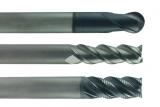Blog
Recent Posts
Do you want to extend the life of your end mills?
Posted by on

The premature wear of your end mills is an added cost to your company but also it affects your productivity. Any talk of milling should start with the feed and speed of cut. This two variables are going to define what’s next.
Feed & Cutting Speed
With the feeding & cutting speeds, we determine the chip-break. For every material type and end mill design, there is a very small range in which we can find the optimized speed for maximizing the efficiency of the tool. Even if you are running your tool at an ideal cutting speed, with a high feed, your tool will break. It does no good to have the correct feed if we don’t have appropriate cutting speed. If it’s too fast, the heat generated will be enough to “soften” the tool, which in term will make our tool dull and will wear faster.
Coatings
Coatings produce a layer that protects the edges of the tool, and in most cases this will upgrade the heat resistance on the tool which is produced while cutting harder materials. The Titanium Nitrate (TiN) coating, offers a protection for general use on HSS and Carbide cutters. Titanium Carbonitride (TiCN) coatings, help carbide cutting tools double their cutting speed without premature wear due to high temperatures. Even with this coating, HSS cutting tools will have a delay on wear as long as the feed & cutting speeds don’t produce too much heat. Coatings with aluminium (TiAN) can withstand higher heat generated by speed and feed which is required to work with high temperature alloys, steels and tempered materials.
Deflection
Deflection is produced when we need to cut material at high cutting speeds or feeds. This creates problems with our cutting tools. Primarily causing our cutting tools to bend. The constant deflection and relaxation of our cutters will weaken them as it happens with normal paper clips. When a tool arches while cutting, the flutes will penetrate too much of the cutting area which will increase the chip volume. The bigger chips can cause our tools to break or to saturate. We can counter the deflection with the appropriate cutting speed and feed and using a shorter and wider cutter.
Chip control
It’s important to clean the cutting area of chips. This will allow us to improve our productivity, finish and performance of our tools. The chips absorb heat from the cutting process and we know that heat is the worst enemy for our cutting tools. Heat also makes other soft materials (Aluminum in particular) to adhere. The aluminum chips will stick to the edges and in no time they will make our cutting useless. Most cutters for aluminum have two or three flutes. With less flutes, more cutting surface is exposed to extract material from the slots or edges. Another form to have chip control is to use coolant. Not only does it reduce the temperature of the chip but it also helps to eject them to the side.
 Loading... Please wait...
Loading... Please wait...
